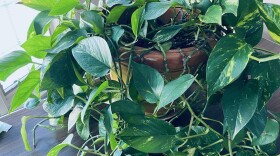Folks, the older I get the more I like to visit places that have a long history. “What about the Bartlett Arboretum?” I asked Iola Humboldt. She consulted her Kansas map, but couldn’t find it. “Let’s just drive to Belle Plain,” I insisted.
Folks, it might not be on the map, but the Bartlett Arboretum is still there, a Kansas treasure, as it has been for 108 years. Dr. Walter Bartlett bought the property in 1910. His son was a star athlete, so Bartlett put a quarter-mile track on the grounds where the high school held races. He added a baseball diamond, complete with bleachers, for community use. He dammed and dredged the Euphrates, the creek that runs through the property, made islands and built bridges. Then he planted trees from all over the world. In 2018, you’ll find the largest Japanese maple in the state of Kansas.
Before long, Bartlett had a show place known to all who wanted to walk in shaded beauty. On today’s grounds, you’ll see tree after champion tree, blue ribbons festooning their trunks. And gardens—hedge, shade, perennial and rock. And floral walks, a white garden, a tree house and gazebo. Rows of cypress and willow drink at the creek side. You’ll see redbuds, birches, magnolias, linden, deciduous holly, cottonwood and an ash from the Biltmore estate. On an open lawn, weddings are held; in an upper clearing the current proprietor of Bartlett Arboretum hopes to restore the prairie.
All that you’ll see is hard won. “The Doctor,” as he was known, continued his interest in the Arboretum until his death in 1937. Closed during the war years, the place was revived by Bartlett’s son Glen, who had spent his youth running the property. Trained as a landscape architect and horticulturalist, Glen ran the property in this new capacity, along with his wife, Margaret, a flower arranger and garden enthusiast as dedicated to the place as Glen. Together, they started the intricate gardens that run through the northeast part of the grounds. They initiated a Tulip Time, planting 40,000 bulbs to delight Kansans.
But by the 1980s, their abilities to keep up the property waned. Mary Bartlett Gourlay, the Doctor’s granddaughter, ran it, then eventually put it up for sale. A Texas woman made a wrong turn in 1997 after visiting the Walnut Valley Festival in Winfield, another great Kansas tradition. She saw the property and was smitten. Robin Macy told Iola and me that her ignorance was bliss. If she’d known the work it would take to restore the Arboretum, all she’d need to learn to do it right, and what she’d have—both glorious in its beauty, but weighted in its responsibilities—she might have turned and run. But she wanted the challenge. A teacher and musician, actually one of the original founders of The Dixie Chicks, Robin has transformed the property. In 2010, the Bartlett Arboretum was placed on the National Register of Historic Sites.
Folks, this is a Great Plains story. We have to take what we value—our places, our traditions, our hard work, our energy and our love of beauty—and make them tangible. Robin Macy has gone from flitting around the garden to being the center of it, from butterfly to butterfly bush. With the help of volunteers—called Soil Sisters and Botanical Brothers—she is moving from restoration to renaissance, with a Bartlett Arboretum Foundation to come. Also to come: a visit from you. It’s up to Kansans to put this place back on the map.







